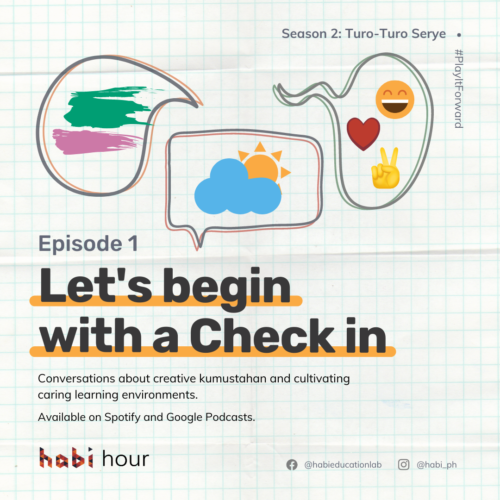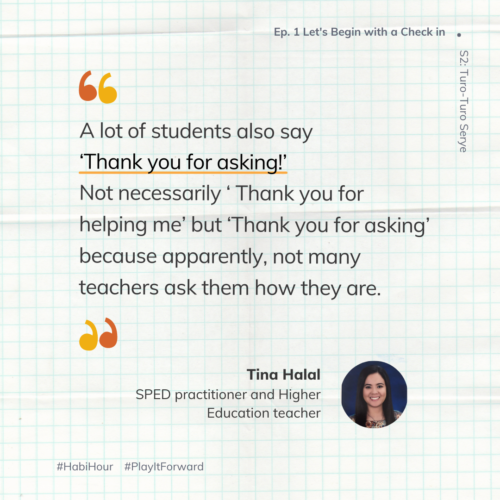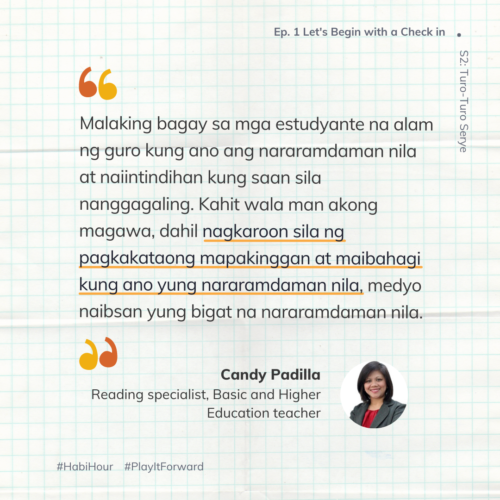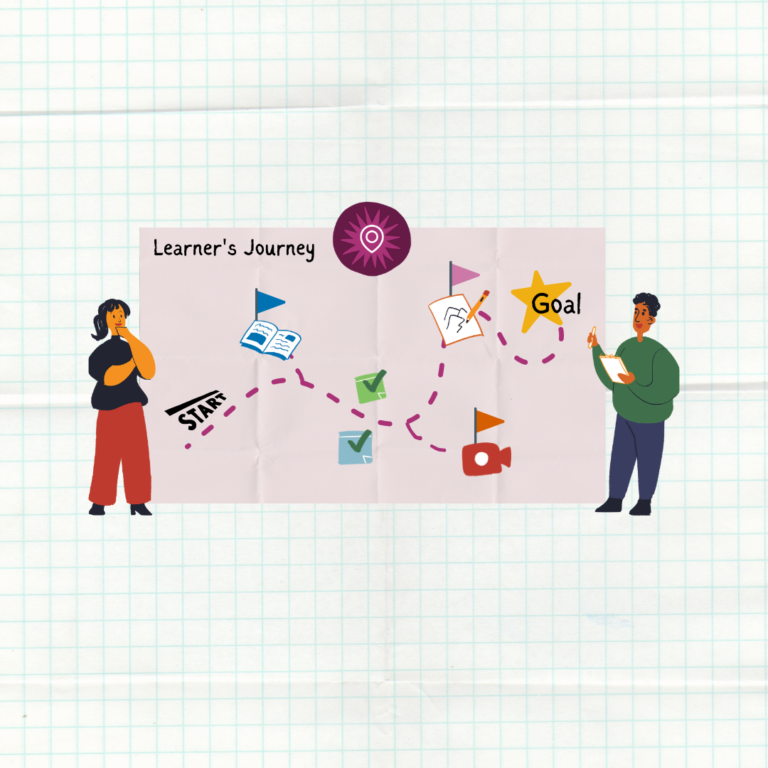Conversations about creative kumustahan and cultivating caring learning environments
Overview
April 9, 2021 | 14 mins and 42s
For our first episode, we talked to Teacher Candy Padilla and Teacher Tina Halal about their experiences in using a creative teaching strategy they first encountered in Habi workshops – check ins. Listen to their stories about creative kumustahan and cultivating a caring learning environment. Ikaw, what color represents how you’re feeling as you listen to this episode? Enjoy!
Transcript
Introductions and Check In
CELINA: Let’s begin with a check in.
[Habi Hour Intro Music]
CELINA: If you have been to any of our workshops and learning sessions, you would have noticed a staple exercise in every single thing that we do – check ins. We start every session with a check in. In a face-to-face setting, this is where we usually gather everyone in a circle – sometimes a seated circle of five, or a standing circle with 180 participants. You might hear someone say:
CHESS: Can we invite everyone to stand up and form one big circle? Let’s see kung ano pong itsura ng bilog natin. Adjust po tayo. We hope that in this circle that we’re making, lahat kasali. Adjust-adjust po tayo. Make sure natin na lahat part of the circle. Walang nasa likod, walang di nakikita. Because the quality of this circle that we’re making also reflects the kind of relationship we want to have in this session.
CELINA: We just heard Chess setting the stage and preparing our participant for a check-in.
CHESS: We begin with a check in. A check in po is a way for us to introduce ourselves and also to ask each other how we are. So it’s a creative way of asking each other kumusta ka? So we’ll be giving a check in prompt and all of us will be answering one by one. We are creating a safe space for each other. So dito po lahat ng sagot pwede. Walang tama o maling sagot. Walang judgments tayong gagawin in our check in responses. Then our prompt is: one word to describe how you’re feeling as we start this activity. So let’s give ourselves a few moments to think, and then I’ll start.
[Habi Hour Intro Spiel]
CELINA: For the first episode of our Turo-Turo Serye, we invited two teachers we first met through our Habi workshops.
TEACHER TINA: I’m Teacher Tina. I’m primarily a SPED practitioner. SPED and Educational Psychology are the courses I teach. I teach both in college and in the masters program.
CELINA: That was Teacher Tina. And now let’s meet Teacher Candy.
TEACHER CANDY: So I’m a reading specialist by profession. Pero I work with children with learning difficulties in a one-on-one setup. Like Teacher Tina, I’m also involved with higher ed. I teach college students also graduate school in Special Education in Early Childhood. And then I also teach a Basic Education class. So medyo malawak yung range. So I work with young children in Basic Ed.
CELINA: Both Teacher Tina and Teacher Candy have been attending Habi workshops since 2017. They first learned about check ins in our workshops and now they’re using check ins in their own classes.
Kuwentuhan
TEACHER TINA: So one time, this is an undergrad class, I asked them, ano ‘to e, parang midterm week, so tinanong ko sila “which color in a traffic light best captures what you’re feeling right at this moment?” So ang daming sagot, three colors lang naman ‘yon, diba? Pero from the responses ng mga estudyante, naging aware ako what they were feeling. Somehow, it became cathartic for them. There were those who were feeling very positive and there were those na talagang kita mo na pagod, na stressed, na anxious na. Kasi dumadami ang requirements kasi nga midterm week. And at the same time, they have their concerns about, you know, the pandemic.
TEACHER CANDY: A lot of students say “thank you for asking.” Not necessarily thank you for helping me, but thank you for asking. Because apparently not too many teachers ask how they are.
TEACHER TINA: Malaking bagay sa mga estudyante na alam ng guro kung ano ang nararamdaman nila at naiintindihan kung saan sila nanggagaling. Kahit wala man akong magawa, dahil nga narinig sila, nagkaroon sila ng pagkakataon na maibahagi kung anong nararamdaman nila, medyo naibsan, i suppose, yung bigat na nararamdaman nila.
Kumusta?
CELINA: You might be wondering kung ang check in ay pangungumusta, baka ginagawa naman na talaga natin siya. Pero paano nga ba naiiba ang check in sa simpleng pangungumusta?
TEACHER CANDY: It’s creative. It’s a creative way of asking one question, which is “kumusta ka?” But then if we always ask “kumusta ka” minsan iisa na lang din yung sagot mo. Not necessarily thinking about if this is how you really feel, pero minsan diba parang “okay lang.” Pero wala ka namang makukuha sa “okay lang.”
TEACHER TINA: Or kung may gusto ka mang sabihin, parang hindi naman ito yung, this is not the right avenue to tell you about my problems.
TEACHER CANDY: Correct! But in a check-in, because it’s a creative way of asking a question, it uses metaphors.
TEACHER TINA: I remember Gerson’s question was, in the very first session we had, I think weather. “What weather are you feeling today?” Medyo psych ‘to ha pero mas madali makapag-project ng… Ano nga ba ako? Am I a thunderstorm? Am I a tropical storm? Or maybe am I just a sunny day? Without being vulnerable.
TEACHER CANDY: Sa Habi ko lang natutunan ‘yon.
TEACHER TINA: Ang maganda din sa check in, hindi mo kailangang ipaliwanag yung sagot mo.
TEACHER CANDY: But there’s a choice, right? The facilitator could say “okay, explain with just a phrase why.” Pero pwede din kasing “no” and just say what your answer is. Because I remember one of the agreements is that it’s a safe space for everybody, so walang judgment. Pag sinabi kong Signal #4 ako ngayon, sige lang. Diba? Tanggap lang siya.
Change in Behavior
CELINA: Now if check ins are a creative way to ask your students “kumusta,” did you observe any changes in your students’ behavior or in your sessions since you started using check-ins?
TEACHER TINA: In the past kasi, before learning about check in, I would always have an icebreaker. Diba that’s what it’s called – icebreaker? And it could be a game. But now that there’s check in, at least it’s simpler. It’s asking a creative question. So it breaks the ice and it builds rapport between the participants or the students and the facilitator. In the evaluation, isa sa mga nagustuhan ng mga studyante talaga ‘yung check in. This is, ano ha, in remote learning. They look forward to the synchronous sessions, once a week lang naman siya, an hour and a half, because of the check in. Because they feel the teachers sincerely care about them.
TEACHER CANDY: For me, naa-appreciate ko ‘yung check ins kasi it allows me to adjust as well. Adjust my energy. And then sometimes, I actually let them know pag ako mismo ‘yung not feeling okay. Kasi syempre diba makiki-check in ka rin as a teacher, sasabhin mo din ‘yung sarili mong thought, ‘yung sarili mong sagot. So pagka kunwari feeling low ako, I let them know.
TEACHER TINA: Ayon, maganda na nakikita din nila that their teachers are human, diba? They go through these challenges, as well, like them. Kung sila nahihirapan, nahihirapan din ang mga guro. So ‘yun lang. Tulangan lang talaga.
Check ins Outside the Learning Setup
CELINA: Now the use of check ins isn’t really limited to a learning setup. So we asked our guests “how else have you used check ins?”
TEACHER TINA: Nagamit ko na siya sa pamilya ko. Pag Zoom. Kasi simula ng pandemic, meron kaming weekly Zoom kumustahan sessions with family. So ang gandang conversation starter n’on because it gives everyone a chance to talk. Tapos parang walang, nafi-fill up yung oras. Kasi biglang from the check in, doon na magsisimula yung ibang conversations. So ‘yon, ako sa pamilya ko. Apart from the meetings, doon ko nagagamit.
TEACHER CANDY: That’s so interesting, Teacher Tina. Gusto ko ‘yang subukan sa pamilya ko.
TEACHER TINA: Interesting malaman ang mga sagot nila.
TEACHER CANDY: Correct. And even with friends, diba? Kasi diba with high school friends, magandang to try that. Pero for me it’s usually in the context of a learning session. Sa parent orientation, open house, lahat ng sessions meron kaming check-in.
Favorite Check Ins
CELINA: A few months ago we asked our social media communities about their favorite check ins. So nand’yan yung classic na “anong luto ng itlog ka ngayon?” Or “what color best represents how you’re feeling right now?” We asked out guests the same thing. So now they’re gonna share with us their favorite check ins. Ready your pens and papers!
TEACHERS TINA AND CANDY: How did you take care of yourself today? What is your weather forecast? What made you smile today? What is your hashtag for the day? What is draining your bucket today, and what is filling it? How can you support yourself? Which color in the traffic light best captures what you’re feeling at this moment? Very simple, what are your top 3 feelings today? In relation to that, I would ask what are you grateful for today? What’s a compliment you’ve received that inspires you to this day? For a basic ed class, I ask them if you could be trapped in a video game for a day, what would it be? Give three songs na parang anthem mo for 2020. (Noong end of the sem, I made them a playlist sa Spotify then I shared it with them.)
Tips for Starting the Use of Check ins
CELINA: Using check ins in your class and in your teaching and learning contexts is going to be a journey. We might not get it right the first time around. But with practice and trust in the process, we will surely understand better the value that it brings to every learning experience. Now we ask Teacher Candy and Teacher Tina to share with us some tips for anyone who might wanna start using check ins.
TEACHER CANDY: Well, number one, use the check ins you’re head before. So from this podcast, and from other posts, para safe. Because the questions have been tried. And so they’re pretty safe questions for one. And then second is make sure that you’re comfortable with that question and you would know how to respond to it. So make sure to allow people to share. In a small group, allow each person to briefly share without having to explain their responses. That’s the third. And the fourth is to acknowledge lang by mirroring or repeating what they said and just acknowledging it. And importante yung saying “thank you.” “Thank you for sharing.” Those tips would be very helpful for teachers who would start to use check ins.
TEACHER TINA: To add, you have to be clear as to why you’re asking the students to check in. I made a mistake a few sems ago to use the check ins as somewhat of a motivational activity. I think in a sense pwede siya. Kaya lang, you also run the risk of getting answers that you might not be prepared for. I agree doon sa sinabi ni Teacher Candy na tried and tested check ins. But also try to look around, ano yung mga questions that also might interest you. Kasi kung ano yung may interest sa’yo, most likely may interest din yung mga studyante.
Check In Playbook
CELINA: We have a surprise for you! Habi is going to release a Check In Playbook this year which has some of our favorite check in prompts. Hopefully, this will be helpful as you try out using check ins in your own settings.
Check Out
CELINA: Now let’s finish this episode by completing this statement: if more people used check ins [blank].
TEACHER CANDY: People will have more empathy for each other.
TEACHER TINA: More students and participants will be happier. Ganoon lang ka-simple.
[Habi Hour Outro]





